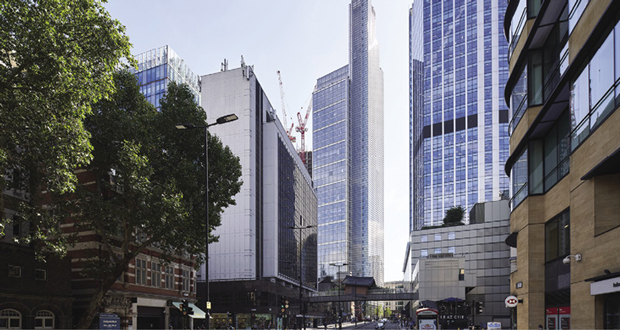Looking to improve the efficiency of your building stock? A digital twin could be the answer, according to HDR | Hurley Palmer Flatt’s Paul Scriven and Dr Annie Marston
Our built environment and its construction have a tremendous role to play in helping the UK meet its carbon dioxide emission reduction targets. We know that buildings have a colossal impact on global carbon emissions. The United Nations Environmental Programme: 2019 Global Status Report for Buildings and Construction(i) figures indicated that as much as 39 per cent of energy-related carbon dioxide emissions can be laid solely at the door of buildings and construction.
Here in the UK the government has set the target of reducing carbon emissions to ‘net zero’ by 2050.
Digital twinning will be a very important tool in helping all those involved in the design, construction, occupation and management of buildings to deliver those efficiencies.
The digital twin concept revolves around the connect between the physical and digital versions of a building. The digital replica reflects exactly the model of the physical version in terms of design and construction and represents – in digital terms – all the building services; lighting, HVAC, mechanical and electrical installations, controls and commissioning throughout. This digital facsimile can play its part in helping us understand how buildings work – and how we can manage and design them more efficiently.
Presently it appears energy modelling and design decisions are mostly taken around the concept of compliance – meeting building regulation standards, hitting (Energy Performance Certificate) EPC(ii) targets etc – but even with a building hitting these benchmarks, its performance in practice may be wildly different to that expected, as we’ve seen in (Display Energy Certificates) DEC’s vs EPC’s(iii).
COMPLIANCE MODEL
When you build a compliance model(iv) it doesn’t necessarily reflect the future performance of the operational building. There is a gap between the designed performance and actual performance of a building which can lead to a lot of confusion for stakeholders when it operates using a completely different energy usage. Here in lies the issue around compliance led design verses performance led design.
A digital twin enables you to move away from compliance modelling and instead try to accurately model the building as it will run once in operation. The full complexities of mechanical systems can be plugged into the model alongside other technical design information, more realistic user profiles, and potentially data from the ‘Internet of Things’. Not only does this mean that anytime anything changes during construction we can understand what impact it might have on the building during operation, but also that this digital model can be used to understand why a building is not behaving as it should.
Faults happen very easily when buildings are in operation – someone might have turned the thermostat off, the lighting might not be working correctly or HVAC controls not set properly – so we can use the digital model as the ideal to help service engineers and FM teams compare, meet and maintain a building’s energy and carbon emission performance as well as ensuring the occupants remain comfortable. A digital twin helps reduce carbon emissions through the design process and also during operation. It gives much more useful information to the design team than a compliance model and encourages performance beyond compliance linked to actual fuel bills and interrogation.
ENERGY MODELLING
There are hopes that the use of digital twins and operational models can be included alongside a review of the current compliance methodology for energy modelling. For instance, SBEM (Simplified Building Energy Model)(v), is a new software tool developed by BRE that provides an analysis of a building’s energy consumption. Incorporating digital twinning into SBEM could really improve it and although infrastructure that offers any peer review of incorporating digital twins into those models is lacking, it is an area where HDR | Hurley Palmer Flatt are frontrunners.
The full incorporation of digital twins into compliance methodology might be a goal for the future but under certification schemes and guidance such as CIBSE’s Technical Memorandum 54(vi), their use can be brought further to the fore.
More enlightened developer clients are starting to recognise the advantages that digital twins can bring to their projects and building portfolio. Not only can they ensure their buildings perform at their most efficient, those advantages can be passed on to their clients and tenants, theoretically making their developments more attractive and easier to sell or let.
RETROFITTING
A building’s age is no hurdle for a digital twin. Refurbishment offers tremendous potential for delivering savings through digital twin methodology – both financial and carbon related.
When carrying out a refurbishment project designers and engineers typically want to remove and renew anything that is close to its end date. Now we can build a digital twin and use it to see how much energy they can save from day one, by using their existing services more efficiently. Then the project teams will have to prove their proposals deliver considerable betterment. If a digital twin is deployed on a new build think how much easier it will be to consider planned maintenance and options for refurbishment on the road to net-zero carbon.
in order to deliver those gains true net-zero carbon planning needs to move away from compliance tools and into a more structured assessment such as CIBSE TM54 or Build for Performance.
We should use digital twin not only for the betterment it delivers but also because the building assessment systems we are using now are not necessarily the most effective or most accurate for all buildings. Compliance has its place, but performance led design needs to be a major part of the process if we are to get it right for 2050. Afterall, compliance led design is traditionally based on historical data so why not make that data more readily available, up to date and accurate.
(i) www.worldgbc.org/news-media/2019-global-status-report-buildings-and-construction
(iii) www.gov.uk/check-energy-performance-public-building
(iv) www.cibse.org/knowledge/knowledge-items/detail?id=a0q20000008JeYXAA0
(v) www.bre.co.uk/page.jsp?id=706
(vi) www.cibse.org/Knowledge/knowledge-items/detail?id=a0q20000008I7f7AAC





